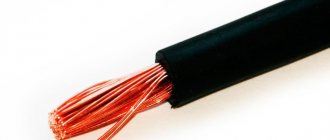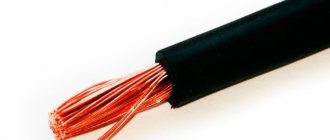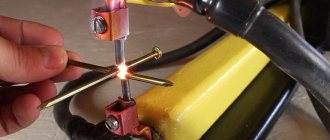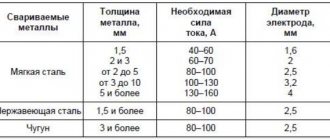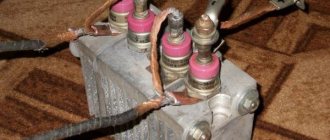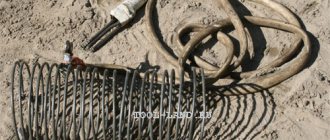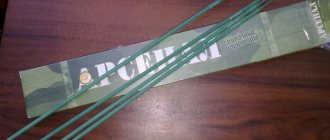The welding cable is an important additional element of welding equipment. It acts as a conductor of significant amounts of current. Without a wire, any equipment does not work and, accordingly, is useless.
on the correct choice of cable cross-section . If the wire cross-section is too small , then the current will not flow through the cord wires and the unit will turn off. larger than necessary can lead to unnecessary costs for its purchase and it will be harder for the welder to carry it.
Our website presents a number of articles devoted to welding cables, analyzing the most important nuances. Next we will consider the main aspects related to this topic. For more detailed information, we recommend following active links.
For which manual arc welding machine what cross-section is needed?
Calculating the cable cross-section based on the current value is the most understandable, simple and fast way, since these two indicators are directly related.
inverter-type machines to perform welding work while professionals focus on transformers and generators . Each unit is capable of delivering different amounts of current. You can find out which conductor should be chosen for different types of equipment in the article “Section of welding cables”.
Which one is needed for mass
The cable for ground clamping ( ground terminals ) and its cross-section must be selected in exactly the same way as a conductor for any type of welding equipment.
Quite often, both experienced and novice welders are faced with the problem of insufficient wire length . Some performers connect two complete conductors into one to clamp the mass, and for the electrode holder they buy an additional cable of the required length. In similar and other similar cases, you should know how to properly connect the cords.
several ways to do this : “twisting”, welding, soldering, crimping, using couplings. Each of the listed methods has its own advantages and disadvantages. About the pros and cons, as well as about the connection technique, see the article “Connection, connection and extension of the welding cable.”
Rules for connection and use
To make a correct connection you need to know the following rules:
- To connect the welder, on one side there are connectors and tips attached to the solder of the device plug.
- Welding cables are connected to each other using crimping. Connections must be insulated.
- The connection is made to the power connectors of the device, the electrode is inserted into a holder attached to the other end of the wire. The main thing is to know the rules of polarity.
- Requirements for welding machines and cable requirements must fully comply with all technical standards, including rated power.
Basic requirements for safe operation
All devices powered by electric current are subject to increased labor protection requirements.
List of basic requirements:
- The core must have a cross-section that can withstand the load from electric current.
- The wire must withstand shock loads and negative influences from aggressive environments.
- The braiding of the welding wires for the inverter must remain elastic and resilient, despite the twisting of the wires.
- It is not allowed to pull the device by the wire.
- The welder must work in appropriate clothing and shoes with mandatory head protection.
- If special clothing and reliable protection against current are not available, then work should not be started.
How to make an extension cord
extension is carried out using almost the same methods as the connection: welding, soldering, crimping. If using one of these methods is impossible for some reason, you should pay attention to additional consumables.
Cable connectors are used to quickly and easily extend wires, as well as to easily connect the cord to a power source. The choice of connectors is carried out depending on the cable cross-section. Welders are offered two types of plugs: pin and socket. For more information, see the article “Welding cable connector”.
1x35, 25 mm2, 16 mm2: what do these numbers mean?
The marking of welding cables includes, in addition to letters, also numerical designations, for example, 1X35 or 16 mm2. Let's take a closer look at the first example. In markings of this type, the number “1” indicates the number of conductive cores, and “35” is the cross-section of the conductor, which is measured in mm2. Therefore, it becomes clear that 16 mm2 is also a designation of the cord cross-section. In a similar way, you can determine the number of cores and their cross-section in any conductor. [ads-pc-3][ads-mob-3]
Additional recommendations
For convenient work, the welder needs a flexible cable (class 4 minimum). Otherwise, it will be inconvenient for the welder to work with such wiring due to its “unruliness”
The wire winding is created according to state standards. The shell thickness must be at least 1.1 mm, otherwise the core will be at risk of being exposed. In addition to the main material (rubber), various components are added to the insulation, for example, rubber, which increases the level of flexibility of welding wires.
The length of the welding wire directly affects the comfort of the worker during welding. Usually, wires 2-3 meters long are enough. For the workshop, it is recommended to use 5-meter cables.
Important! Do not increase the cable length. The longer the cord, the higher the resistance.
The longest cable length is calculated from the maximum current carrying capacity divided by one hundred. After which the diameter of the cord is divided by the number obtained earlier. The result will be the longest welding cable length.
Using recommendations for choosing welding wires, you will be able to select the necessary cable that exactly suits the given operating conditions.
Copper or aluminum
The cable products market includes copper and aluminum conductors. Many performers wonder: which cable is better and will last longer?
Wires with copper conductors have several advantages over aluminum ones:
- copper is a better current conductor than aluminum;
- welding cables must be highly flexible , therefore, in this case, the use of wires with copper conductors is also preferable;
- copper cords can withstand repeated winding and unwinding without damage to the wires.
However, it is worth noting that Resanta devices, which are in demand among performers, are equipped with an aluminum cable. Therefore, when choosing, in addition to general recommendations, you should focus on your own feelings from welding.
Is it possible to extend the welding cable
The length of the welding cable should not exceed 3 m. It is difficult to work with such a product, especially at height. Manufacturers do not recommend increasing the length further.
What negative situations may arise:
- Sharp drop in current.
- Increase in voltage due to self-induced emf.
- The output electrodes may be punctured.
To avoid this, a choke was used on the devices. The product was installed to accumulate energy and release it to form an arc when the transistors are closed and there is no current in the primary winding. Many manufacturers do not include these devices in their products because the price of the equipment increases.
Extension of the cable is not recommended, this is due to the fact that it has reactive and active resistance. As a result, the output voltage and current drop.
If the length of the wire changes, the operation of the entire system may be disrupted and even the equipment may fail.
In practice, it has been established that an increase in length up to 5 m is acceptable if the cross-section of the welding cable matches.
Types
Some performers believe that by cable types, they mean division by the number of cores and wire cross-section. However, this is not an entirely correct point of view. In most cases, we are talking about the fact that conductors are flexible () and especially flexible (COG).
Each type has several varieties , which are intended for use in different climatic conditions: HL - cold-resistant; T – tropical; n – non-combustible insulation. These designations are present in the markings of the conductors, so it will be easy for any performer to identify the specific type. KG and KOG have design features presented in the article “Brands of welding cables”.
Power for inverter
The power cable consists of several insulated wires in a hermetically sealed sheath, used to connect welding machines to electrical networks of 220 V or 380 V. The most common brands of this type of conductor are presented in the article “Length and connection of welding cables.”
In addition, we recommend that you read the article “Welding cable for an inverter,” which presents the main types of wires for this type of equipment, analyzes important aspects of choosing the cross-section of the cord, and lists the rules for connecting the wire to the equipment.
Welding cable brands and their characteristics
Welding wires are subject to increased loads from equipment and environmental factors. The service life of the welding cable depends on the correct choice. The welding cable is marked with digital and letter symbols. To help you choose which cable to choose, the descriptions below are given.
Description of flexible welding cable KG
The meaning of the letters “KG” in the marking means that the cable is flexible. This is a common type of product. Operates with direct current with a voltage rating of up to 1000 V, with alternating current - not exceeding 600 V, at a frequency of not more than 400 Hz. Connects from a 220 or 380 V network or by connecting a holder and a clamp.
Cable for welding work KOG1
To manufacture the product, conductors with small cross-section diameters are used. This is useful when creating seams in inaccessible places. To prevent loops from sticking out on the sides, you can use the cable wound around your hand. This is convenient when working at heights.
Designed for operation at a voltage of 220 V and a frequency of 50 Hz.
Welding cable KGN
KGN, the letter “N” means that the wire is fireproof. The insulating layer is made of a heat-resistant compound and can withstand temperatures of more than 200 0C. This cable can be used not only for welding, but for cutting (plasma or electrode), for example, for emergency work in case of emergency situations.
The wire will not melt when it comes into contact with heated metal products.
KG HL
The product index contains the designation “HL”, that is, it can be used in frosty conditions. It contains rubber that can withstand the cold. Flexibility is maintained at temperatures down to -60 0C, making the wires ideal for northern regions. If work is carried out in open areas, then attention should be focused on this product.
Welding cable KPES
The product is intended for semi-automatic welding or is a cable for a welding inverter. This variety uses spiral tubes instead of wires. In order for the circuit to be closed and the electric arc to be excited, a wire is passed inside the cord, which can be of three types:
- whole;
- tubular;
- with flux.
The cost depends on the size of the internal diameter. If the structure is hollow, then the service life is reduced by one and a half years. The electric main supplies voltage from 42 to 48 V at direct or alternating current. At temperatures down to -10 0C, a low-voltage line is used.
Useful article - Everything you need to know about Poxypol glue to avoid welding
PIC
The insulating layer uses polyvinyl chloride. The product is resistant to abrasion and is ideal when a worker needs to constantly move, dragging the cable behind him. The core is preserved due to reliable insulation. Operates under a load of 127 or 220V, at temperatures from -40 to +400C, not flexible. Welding wires for the inverter are used to connect to the outlet.
Welding cable brand KGT
The product is designed for high temperatures. Operation of the product is possible at +850C. The product is suitable for use in humid climates.
KRPT model
This wire is flexible with cores. The veins are made of copper. The shell and insulation are made of rubber. The welding cable is manufactured by the manufacturer to work with the following parameters:
- At 660V AC and 110V DC.
- Permissible current load from 3 to 20A/mm2.
- Temperature range from -60 to +500С.
The cross-section of the welding cable depends on the number and cross-section of the cores - from 8 to 69 mm. The product is not flammable.
